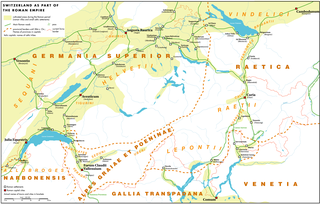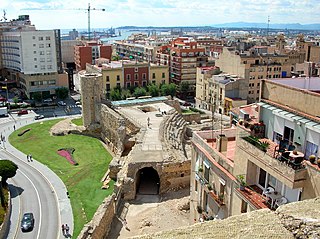
Tarragona is a port city located in northeast Spain on the Costa Daurada by the Mediterranean Sea. Founded before the fifth century BC, it is the capital of the Province of Tarragona, and part of Tarragonès and Catalonia. It shares a border in the north with the Province of Barcelona and the Province of Lleida.

Ancient Roman temples were among the most important buildings in Roman culture, and some of the richest buildings in Roman architecture, though only a few survive in any sort of complete state. Today they remain "the most obvious symbol of Roman architecture". Their construction and maintenance was a major part of ancient Roman religion, and all towns of any importance had at least one main temple, as well as smaller shrines. The main room (cella) housed the cult image of the deity to whom the temple was dedicated, and often a table for supplementary offerings or libations and a small altar for incense. Behind the cella was a room or rooms used by temple attendants for storage of equipment and offerings. The ordinary worshiper rarely entered the cella, and most public ceremonies were performed outside where the sacrificial altar was located, on the portico, with a crowd gathered in the temple precinct.

Tarraco is the ancient name of the current city of Tarragona. It was the oldest Roman settlement on the Iberian Peninsula. It became the capital of Hispania Tarraconensis following the latter's creation during the Roman Empire.

The Imperial Fora are a series of monumental fora, constructed in Rome over a period of one and a half centuries, between 46 BC and 113 AD. The fora were the center of the Roman Republic and of the Roman Empire.
A forum was a public square in a Roman municipium, or any civitas, reserved primarily for the vending of goods; i.e., a marketplace, along with the buildings used for shops and the stoas used for open stalls. Many fora were constructed at remote locations along a road by the magistrate responsible for the road, in which case the forum was the only settlement at the site and had its own name, such as Forum Popili or Forum Livi.

Al-Marwani Mushalla, or Al-Marwani Mosque, is an underground vaulted prayer hall in the Al-Aqsa mosque compound in Jerusalem. It is 600 square yards in area, and is located under the southeastern corner of the compound, 12.5 m (41 ft) below the courtyard, and features twelve rows of pillars and arches. In December 1996 the Jerusalem Waqf renovated the area. The area was known to the Crusaders as Solomon's Stables, and to earlier Muslims as the Old Mosque.

The Temple of Vespasian and Titus is located in Rome at the western end of the Roman Forum between the Temple of Concordia and the Temple of Saturn. It is dedicated to the deified Vespasian and his son, the deified Titus. It was begun by Titus in 79 after Vespasian's death and Titus's succession. Titus’ brother, Domitian, completed and dedicated the temple to Titus and Vespasian in approximately 87.
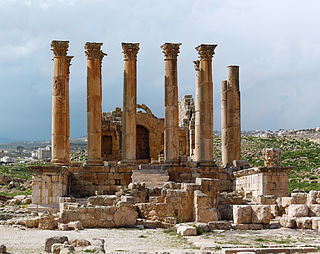
The Temple of Artemis at Gerasa is a Roman peripteral temple in Jerash, Jordan. The temple was built in the middle of the highest of the two terraces of the sanctuary, in the core of the ancient city. The temple is one of the most remarkable monuments left in the ancient city of Gerasa (Jerash) and throughout the Roman East.
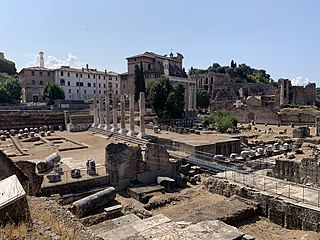
The Temple of Peace, also known as the Forum of Vespasian, was built in Rome in 71 AD under Emperor Vespasian in honour to Pax, the Roman goddess of peace. It faces the Velian Hill, toward the famous Colosseum, and was on the southeast side of the Argiletum.

Forum of Nerva is an ancient structure in Rome, Italy, chronologically the next to the last of the Imperial fora built.
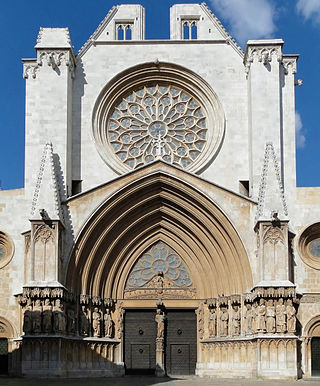
The Primatial Cathedral of Tarragona is a Roman Catholic church in Tarragona, Catalonia, Spain. The edifice is located in a site previously occupied by a Roman temple dating to the time of Tiberius, a Visigothic cathedral, and a Moorish mosque. It was declared a national monument in 1905.

The Romanization of Hispania is the process by which Roman or Latin culture was introduced into the Iberian Peninsula during the period of Roman rule.

The Spanish city of Córdoba has the remains of a Roman temple, which was discovered in the 1950s during the expansion of City Hall. It is located in the angle formed by the streets Claudio Marcelo and Capitulares. It was not the only temple that the city had, but it was possibly the most important of all, and the only known by archaeological excavation. It is a Pseudoperipterus, hexastyle and of Corinthian order temple of 32 meters long and 16 wide.

Longobards in Italy: Places of Power is seven groups of historic buildings that reflect the achievements of the Germanic tribe of the Lombards, who settled in Italy during the sixth century and established a Lombard Kingdom which ended in 774 A.D.
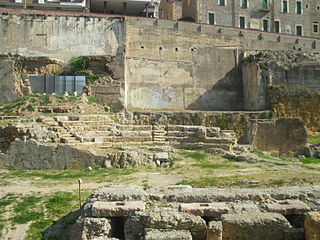
The Roman theatre of Tarraco was a Roman theatre built in Tarraco in the time of Augustus in the area of the local forum and the port, the planners took advantage of the steep slope of the hill to build part of the seating.

The Roman quarry of El Mèdol was first excavated during the period of the Roman Republic and the Roman Empire.

The Palace of Domitian was built as Roman emperor Domitian's official residence in 81–92 AD and was used as such by subsequent emperors. Its remains sit atop and dominate the Palatine Hill in Rome, alongside other palaces.

Qalaat Faqra is an archaeological site in Kfardebian, Lebanon, with Roman and Byzantine ruins. Located near the Faqra ski resort on the slopes of Mount Sannine at an altitude of 1500 m, it is one of the most important sites of the UNESCO-listed valley of Nahr al-Kalb.
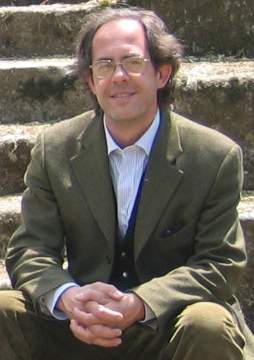
Xavier Dupré i Raventós was a Spanish archaeologist and historian of classical antiquity. He was the first provincial archaeologist appointed by the archaeological division of the Generalitat de Catalunya in Tarragona. He was also director of Taller–Escola d’Arqueologia de Tarragona (TED’A), director of excavations of the Roman city of Tusculum and deputy director of the Escuela Española de Historia y Arqueología in Rome.







